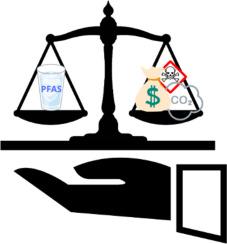从生命周期角度回顾PFAS水处理技术,并对财务成本和气候影响进行荟萃分析
IF 10.9
1区 环境科学与生态学
Q1 ENGINEERING, ENVIRONMENTAL
引用次数: 0
摘要
饮用水的全氟和多氟烷基物质污染现在是一个严重的环境和公共卫生问题。常规的水处理是无效的,这促使人们投资于颗粒活性炭、离子交换、膜过滤、泡沫分馏和电化学氧化等解决方案。但是,选择适当的技术需要在性能、资源使用和环境影响标准之间进行权衡。我们的分析旨在为每克PFAS去除对气候的影响以及每体积水处理的年度资本和运营成本提供新的见解。我们还强调了PFAS处理的环境评估的关键局限性,特别是在毒性相关影响方面,这些局限性没有跟上生命周期评估方法的发展。我们的分析综合了来自17个不同的PFAS治疗技术出版物的数据。创新处理方法的排放差异很大,气候影响范围为每克PFAS 0.1至70 190千克二氧化碳当量,具体取决于原水PFAS浓度。经济分析表明,运营成本在0.03美元/m³至28美元/m³之间,而资本支出在0.01美元至0.51美元/m³之间,表现出一定的规模经济。这项工作还强调了使用生命周期评估和生命周期成本方法来全面评估PFAS去除技术的重要性。本文章由计算机程序翻译,如有差异,请以英文原文为准。

Review of water treatment technologies for PFAS from a life cycle perspective, with meta-analysis of financial costs and climate impacts
Per- and polyfluoroalkyl substances (PFAS) contamination of drinking water is now a critical environmental and public health concern. Conventional water treatment is ineffective, prompting investment in solutions like granular activated carbon, ion exchange, membrane filtration, foam-fractionation and electrochemical oxidation. However, selecting appropriate technologies involves trade-offs among performance, resource use and environmental impact criteria. Our analysis aims to offer new insights into the climate impacts per gram of PFAS removed and the annual capital and operational costs per volume water treated. We also highlight critical limitations of environmental assessment of PFAS treatments, particularly regarding toxicity-related impacts, that have not kept pace with developments in life cycle assessment methodology. Our analysis synthesizes data from 17 disparate publications on PFAS treatment technologies. Emissions from innovative treatments vary widely, with climate impacts ranging from 0.1 to 70 190 kg CO2 eq. per gram of PFAS depending on raw water PFAS concentrations. The economic analysis showed that operational costs span from $0.03/m³ to $28/m³, while capital expenditures range from $0.01 to $0.51/m³ of water treated and exhibit some economies of scale. This work also underscores the importance of using life cycle assessment and life cycle costing approaches to comprehensively evaluate PFAS removal technologies.
求助全文
通过发布文献求助,成功后即可免费获取论文全文。
去求助
来源期刊

Resources Conservation and Recycling
环境科学-工程:环境
CiteScore
22.90
自引率
6.10%
发文量
625
审稿时长
23 days
期刊介绍:
The journal Resources, Conservation & Recycling welcomes contributions from research, which consider sustainable management and conservation of resources. The journal prioritizes understanding the transformation processes crucial for transitioning toward more sustainable production and consumption systems. It highlights technological, economic, institutional, and policy aspects related to specific resource management practices such as conservation, recycling, and resource substitution, as well as broader strategies like improving resource productivity and restructuring production and consumption patterns.
Contributions may address regional, national, or international scales and can range from individual resources or technologies to entire sectors or systems. Authors are encouraged to explore scientific and methodological issues alongside practical, environmental, and economic implications. However, manuscripts focusing solely on laboratory experiments without discussing their broader implications will not be considered for publication in the journal.
 求助内容:
求助内容: 应助结果提醒方式:
应助结果提醒方式:


